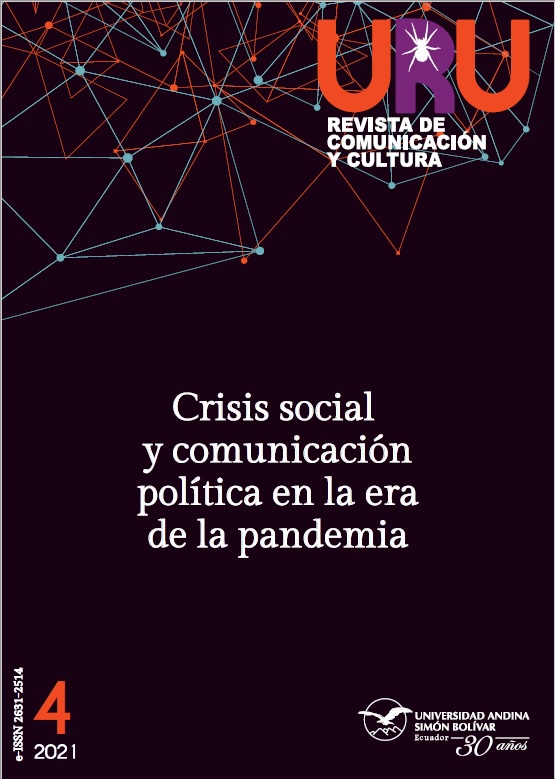Incidence Factors in the Ecuadorian System of Film Censorship by Age
DOI:
https://doi.org/10.32719/26312514.2021.4.11Keywords:
Censorship, implicit attitudes, communication, film, movie ratings, regulationAbstract
The criteria developed by ICCA for cinematographic censorship in Ecuador with the intention of an objective process of movie rating by age groups. It presented the perfect opportunity to study their application from the perspective of the person who uses them. Integrating concepts and knowledge in the fields of communication and psychology. With the intention of fully exploring the factors that affect the rating process. Factors such as the personal history of participants, even their implicit attitudes towards the audiovisual material presented. For this, a procedure was carried out to collect personal data and detect implicit attitudes in a sample of 15 Ecuadorian participants. Who saw a compilation of 11 movie clips, while engaged in a distraction activity. In order for them to place the films within the age qualification that they considered best applied for that fragment, according to its thematic axis.
Downloads
References
Dasgupta, Nilanjana. 2013. “Implicit Attitudes and Beliefs Adapt to Dituations: A Decade of Research on the Malleability of Implicit Prejudice, Stereotypes, and the Self-Concept”. Advances in Experimental Social Psychology 47: 233-79. https://doi.org/10.1016/B978-0-12-407236-7.00005-X.
Dill, Karen (ed.). 2013. The Oxford Handbook of Media Psychology. Nueva York: Oxford University Press.
EC Instituto de Cine y Creación Audiovisual. 2019. “Instructivo para la Certificación de Calificación por Grupos de Edad de obras cinematográficas y audiovisuales para su exhibición”.
—. 2020. “Resolución Nro. ICCA-DE-2020-002”.
Ferguson, Christopher. 2016. Media Psychology 101. Nueva York: Springer Publishing Company.
Freire, Juan José. 2021. Análisis de factores científicos, morales y subjetivos que determinan el sistema ecuatoriano de censura cinematográfica por edades. Quito: Universidad Andina Simón Bolívar, Sede Ecuador.
Giles, David. 2003. Media Psychology. Nueva Jersey: Lawrence Erlbaum Associates.
Gubern, Román. 1981. La censura. Función política y ordenamiento jurídico bajo el franquismo. 1936-1975. Barcelona: Península.
Jones, Derek, ed. 2015. Censorship: A World Encyclopedia. Abingdon, US: Routledge.
Lanciano, Tiziana, Emanuela Soleti, Francesca Guglielmi, Ivan Mangiulli, y Antonietta Curci. 2016. “Fifty Shades of Unsaid: Women’s Explicit and Implicit Attitudes towards Sexual Morality”.
Europe’s Journal of Psychology 12 (4): 550-66.https://doi.org/10.5964/ejop.v12i4.1124.
Marín, Antonio Lucas, Carmen García, y José Antonio Ruiz. 2003. Sociología de la comunicación. Valladolid, ES: Trotta.
McIntyre, Jeff. 2013. “The Political Narrative of Children’s Media Research”. En The Oxford Handbook of Media Psychology, editado por Karen Dill, 462-73. Nueva York: Oxford University Press.
Payne, B. Keith, y Sonya Dal Cin. 2015. “Implicit Attitudes in Media Psychology”. Media Psychology 18 (3): 292-311. https://doi.org/10.1080/15213269.2015.1011341.
Reeves, Byron, Leo Yeykelis, y James Cummings. 2016. “The Use of Media in Media Psychology”. Media Psychology 19 (1): 49-71. https://doi.org/10.1080/15213269.2015.1030083.
Downloads
Published
How to Cite
Issue
Section
License
ASSIGNMENT OF RIGHTS, DECLARATION OF CONFLICT OF INTEREST AND DISSEMINATION
The authors who publish in this journal accept the following conditions:
- Authors retain copyright and grant the journal the right of first publication, with the work registered under the Creative Commons Attribution-NonCommercial-ShareAlike 4.0 License, which allows sharing, adapting and attributing the work (see: Open Access Policies).
- Authors can make other independent and additional contractual agreements for the distribution of the article published in this journal (e.g., include it in an institutional repository or publish it in a book) as long as they expressly indicate that the article was published for the first time in Uru: Revista de Comunicación y Cultura. In the case of reproduction, a note similar to the following must be included: This text was originally published in the journal Uru: Revista de Comunicación y Cultura N ° -, year of publication.
- Authors are encouraged to publish their work on the Internet (e.g. on institutional or personal pages) in the final version published by Uru: Revista de Comunicaicón y Cultura as it may lead to a wider and faster dissemination of the published work.








